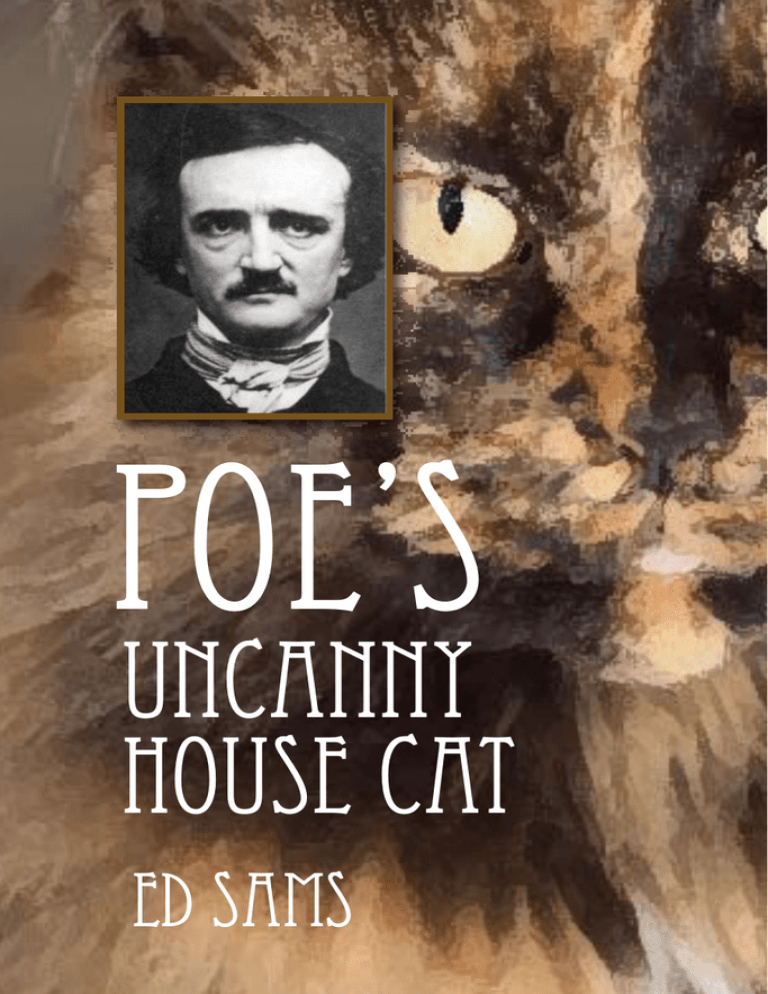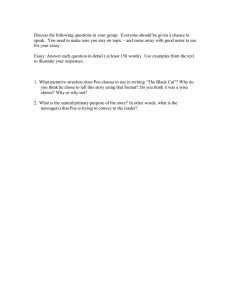
Poe’s
uNCANNY
hOUSE cAT
Ed Sams
POE’S
UNCANNY
HOUSE CAT
ED SAMS
Yellow Tulip Press
www.curiouschapbooks.com
Copyright 2002 - 2014 by Ed Sams
All rights reserved. No part of this book may be reproduced without written permission from the publisher, except by reviewers who may quote brief passages in a review. Nor may any part of this book be reproduced,
stored in a retrieval system, or transmitted in any form or by any means electronic, mechanical, photocopying,
recording, or other without written permission from the publisher.
Published by Yellow Tulip Press
PO Box 211
Ben Lomond, CA 95005
www.curiouschapbooks.com
Printed in the United States of America.
To Professor Kristen Iversen
San Jose State University
CONTENTS
Cattarina . . . . . . . . . . . . . . . . . .3
Muddy . . . . . . . . . . . . . . . . . . .7
Sissy . . . . . . . . . . . . . . . . . . . .15
Eddie . . . . . . . . . . . . . . . . . . .23
Postscript . . . . . . . . . . . . . . . .27
Sources . . . . . . . . . . . . . . . . . .29
“My immediate purpose is
to place before the world,
plainly, succinctly, and
without comment, a series
of mere household events.”
--From Edgar Allan Poe’s “The Black Cat”
Cattarina
E
dgar Allan Poe once belonged to a house cat. Her name was Cattarina. Cattarina lived with the poet, his wife Virginia, and her mother
Maria Clemm in snug little houses in both Philadelphia and New
York. The Poe household was so close that none stood on ceremony. The
great poet was Eddie, Mrs. Poe was Sissy, and Mrs. Clemm was Muddy.
Even Cattarina had nicknames; sometimes she was called Catters, sometimes Kate. Sometimes Cattarina spelled her name with one T, and
sometimes with two. That comes from living in a literary household.
Sometimes Eddie signed his name E. A. Poe, sometimes Edgar Poe,
once as Edgar Perry, as well as Edgar Allan Poe.
No one knows when Cattarina first became a member of the Poe family.
The great Poe scholar Hervey Allen places Cattarina with the Poes either
late in 1839 or early in 1840 when the family moved to Coates Street in
Philadelphia and “Cattarina, the cat, then in her burgeoning kittenhood,
purred on the ample plateau of Mrs. Clemm’s lap” (371).
There are clues in Poe’s own writing to suggest that he was a cat owner
as early as 1840. In “The Business Man,” the man of business comments, “My eighth and last speculation has been in the Cat-Growing
way. I have found this a most pleasant and lucrative business, and, really,
no trouble at all.” Furthermore, in January 1840, Alexander’s Weekly
Messenger published Poe’s essay, “Instinct vs. Reason--A Black Cat.” In
it, Poe argues that animal instinct may be a more powerful psychic force
than human intellect. He explains, “Instinct, so far from being an inferior
3
Poe’s Uncanny House Cat
Ed Sams
reason, is perhaps the most exacted intellect of all. It will appear to the true
philosopher as the divine mind itself acting immediately upon its creatures
(The Unknown Poe 65). The author’s prime example is his own pet and her
method of opening a door latch. He explains:
But puss is in the daily habit of opening the door, which
she accomplishes in the following way. She first springs
from the ground to the guard of the latch (which resembles the guard over a gun trigger) and through this she
thrusts her left arm to hold on with. She now, with her
right hand, presses the thumb latch until it yields and
here several attempts are requisite. Having forced it
down, however, she seems to be aware that her task is
but half accomplished…She, therefore, screws her body
round so as to bring her hind feet immediately beneath
the latch, while she leaps with all her strength from the
door--the impetus of the spring [forces] it open… (Unknown Poe 66).
Cattarina must have been a very clever and willful cat to have
opened the door and to have inspired this essay. One can only wonder what other psychic energy she expended upon her owner besides
literary inspiration.
“Instinct vs. Reason--A Black Cat” anticipates by three years Poe’s masterpiece of horror “The Black Cat,” but there is evidence that Poe is discussing the same creature in both works. In “Interest vs. Reason,” Poe
comments, “The writer of this article is the owner of one of the most remarkable black cats in the world…and this is saying much; for it will be
remembered that black cats are all of them witches.” Then, later in “The
Black Cat,” the drunken narrator confides that “my wife, who at heart
was not a little tinctured with superstition, made frequent allusion to the
popular notions, which regarded all black cats as witches in disguise.”
Witch or not, by the time the United States Saturday Post published
“The Black Cat” in 1843, Cattarina was already an accepted member of
4
Ed Sams
Poe’s Uncanny House Cat
the family. Here is how biographer Frances Winwar imagines the Poe
household in January 1842: “There was nothing Mrs. Clemm liked better
than to preside over the tea and coffee urns while a fire burned on the
hearth, the guests sat in the straight, flower-painted chairs, and the new
member of the family, a tortoise-shelled cat named Cattarina (for the pun
in the name) basked in the warmth of the fire place” (220). At that time
Eddie and Sissy had been married six years. He was thirty-two and she
was not yet twenty.
It well may be that Cattarina first belonged to Sissy and that she gave the cat
to her husband as a gift, just as the drunkard’s wife did in “The Black Cat,”
for the drunkard states, “We had birds, gold fish, a fine dog, rabbits, a small
monkey, and a cat. This latter was a remarkably large and beautiful animal,
entirely black, and sagacious to an astonishing degree” (382).
Although this cat, Pluto, was entirely black, as was the cat in “Instinct
vs. Reason,” Cattarina was not. She has been described as tortoiseshell,
which is “generally a mixture of black and orange markings, with the orange markings showing a tabby pattern” (Jay 134). Even still, there can
be many subtleties in orange and black colors, for the tortoiseshell is a
three-colored cat (Morris 248). In fact, Desmond Morris lists at least
twenty-two variant shades of tortoise shell including Blue, Chocolate,
Smoke, Cinnamon, Ebony, Lilac, Seal, Lynx Point, and Chintz (249).
History does not record Cattarina’s exact shade of tortoiseshell; however, there is a first-hand glimpse provided by Editor George R. Graham,
who mentions Cattarina’s markings in describing Virginia Poe’s bedroom. Graham writes of a visit he paid Virginia during her illness in
1848: “She lay on the straw bed, wrapped in her husband’s greatcoat,
with a large tortoiseshell cat at her bosom. The wonderful cat seemed
conscious of her great usefulness” (Memoir 70). Cattarina was conscious
of much going on in her home, but she kept her own counsel while
working her secret wiles.
So Cattarina was not entirely black, but then neither was the second cat
in “The Black Cat.” The first cat disappears early in the tale. With tears
in his eyes, the drunken narrator makes a noose and hangs his own
5
Poe’s Uncanny House Cat
Ed Sams
beautiful black cat, Pluto, because he admits, “I knew it loved me.” Only
later does he find the second cat: “It was a black cat--a very large one--fully
as large as Pluto, and closely resembling him in every respect but one. Pluto
had not a white hair upon any portion of his body; but this cat had a large,
although indefinite, splotch of white, covering nearly the whole region of the
breast.” Later the drunkard’s wife calls his attention “to the mark of the
white hair” which gradually forms through the drunkard’s imagination into
the appearance of a noose around the second cat’s neck.
If Sissy did not give Cattarina to her husband, Eddie might very well have
found her the same way the drunkard found this second uncanny cat. Perhaps
Edgar Allan Poe met Cattarina on one of his jaunts along Philadelphia’s Front
Street or Lower Dock. The drunkard in “The Black Cat” recalls:
One night as I sat, half stupefied in a den of more than
infamy, my attention was suddenly drawn to some black
object, reposing upon the head of one of the immense
hogsheads of Gin, or of Rum, which constituted the chief
furniture of the apartment. I had been looking steadily
at the top of this hogshead for some minutes, and what
now caused me surprise was the fact that I had not
sooner perceived the object thereupon. I approached it,
and touched it with my hand…when I prepared to go
home, the animal evinced a disposition to accompany
me. I permitted it to do so; occasionally stooping and
patting it as I proceeded. When it reached the house it
domesticated itself at once, and became immediately a
great favorite with my wife (384).
With Cattarina now in the home, the Poe household was not entirely
childless, although Muddy may have considered Eddie and Sissy children enough to take care of already.
6
For the Whole Story,
Order ‘Poe’s Uncanny House Cat’
from www.curiouschapbooks.com
or Amazon.com






